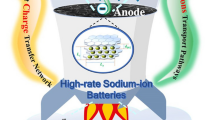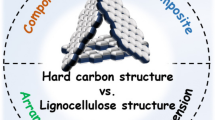Abstract
Herein, a facile strategy for the synthesis of sandwich pyrolyzed bacterial cellulose (PBC)/graphene oxide (GO) composite was reported simply by utilizing the large-scale regenerated biomass bacterial cellulose as precursor. The unique and delicate structure where three-dimensional interconnected bacterial cellulose (BC) network embedded in two-dimensional GO skeleton could not only work as an effective barrier to retard polysulfide diffusion during the charge/discharge process to enhance the cyclic stability of the Li–S battery, but also offer a continuous electron transport pathway for the improved rate capability. As a result, by utilizing pure sulfur as cathodes, the Li–S batteries assembled with PBC/GO interlayer can still exhibit a capacity of nearly 600 mAh·g−1 at 3C and only 0.055% capacity decay per cycle can be observed over 200 cycles. Additionally, the cost-efficient and environment-friendly raw materials may enable the PBC/GO sandwich interlayer to be an advanced configuration for Li–S batteries.








Similar content being viewed by others
References
Evers S, Nazar LF. New approaches for high energy density lithium–sulfur battery cathodes. Acc Chem Res. 2013;46(5):1135.
Bruce PG, Freunberger SA, Hardwick LJ, Tarascon JM. Li–O2 and Li–S batteries with high energy storage. Nat Mater. 2012;11(2):19.
Ji X, Lee KT, Nazar LF. A highly ordered nanostructured carbon-sulphur cathode for lithium-sulphur batteries. Nat Mater. 2009;8(6):500.
Zhang C, Lv W, Zhang W, Zheng X, Wu MB, Wei W, Tao Y, Li Z, Yang QH. Reduction of graphene oxide by hydrogen sulfide: a promising strategy for pollutant control and as an electrode for Li–S batteries. Adv Energy Mater. 2014;4(7):175.
Manthiram A, Fu Y, Su YS. Challenges and prospects of lithium–sulfur batteries. Acc Chem Res. 2013;46(5):1125.
Yang Y, Zheng G, Cui Y. Nanostructured sulfur cathodes. Chem Soc Rev. 2013;42(7):3018.
Xiao L, Cao Y, Xiao J, Schwenzer B, Engelhard MH, Saraf LV, Nie Z, Exarhos GJ, Liu J. A soft approach to encapsulate sulfur: polyaniline nanotubes for lithium–sulfur batteries with long cycle life. Adv Mater. 2012;24(9):1176.
Zhou G, Li L, Wang DW, Shan XY, Pei S, Li F, Cheng HM. A flexible sulfur-graphene-polypropylene separator integrated electrode for advanced Li–S batteries. Adv Mater. 2015;27(4):590.
Wang W, Shi Y, Li M, Wang Z, Wu S, Lyu F, Shang C, Lu Z. Ultrafine N-doped carbon nanoparticles with controllable size to enhance electrocatalytic activity for oxygen reduction reaction. RSC Adv. 2016;6(112):110758.
Zhang X, Zhang X, Lin Z, Yu M, Lu X, Tong Y. Recent advances and challenges of stretchable supercapacitors based on carbon materials. Sci China Mater. 2016;59(6):475.
Li M, Tang M, Deng J, Wang Y. Nitrogen-doped flower-like porous carbon materials directed by in situ, hydrolysed MgO: promising support for Ru nanoparticles in catalytic hydrogenations. Nano Res. 2016;10:3129.
Shang C, Li M, Wang Z, Lu Z. Electrospun nitrogen-doped carbon nanofibers encapsulating cobalt nanoparticles as efficient oxygen reduction reaction catalysts. Chem Electro Chem. 2016;3(9):1437.
Zhang X, Zhang H, Lin Z, Zafar ZA, Yu M, Lu X, Tong Y. Recent advances and challenges of stretchable supercapacitors based on carbon materials. Sci China Mater. 2016;59(6):475.
Manthiram A, Fu Y, Chung SH, Zu C, Su YS. Rechargeable lithium–sulfur batteries. Chem Rev. 2014;114(23):11751.
Pang Q, Liang X, Kwok CY, Nazar LF. Advances in lithium–sulfur batteries based on multifunctional cathodes and electrolytes. Nat Energy. 2016;1(9):16132.
Chen S, Huang X, Liu H, Sun B, Yeoh W, Li K, Zhang J, Wang G. Batteries: 3D hyperbranched hollow carbon nanorod architectures for high-performance lithium–sulfur batteries. Adv Energy Mater. 2014;4(8):1079.
Gu X, Lai C, Liu F, Yang W, Hou Y, Zhang S. A conductive interwoven bamboo carbon fiber membrane for Li-S batteries. J Mater Chem A. 2015;3(18):9502.
Wang DW, Zeng Q, Zhou G, Yin L, Li F, Cheng HM, Gentle IR, Lu GQM. Carbon-sulfur composites for Li–S batteries: status and prospects. J Mater Chem A. 2013;1(33):9382.
Qie L, Manthiram A. A facile layer-by-layer approach for high-areal-capacity sulfur cathodes. Adv Mater. 2015;27(10):1694.
Gu X, Wang Y, Lai C, Qiu J, Li S, Hou Y, Martens W, Mahmood N, Zhang S. Microporous bamboo biochar for lithium–sulfur batteries. Nano Res. 2015;8(1):129.
Wei SZ, Li W, Cha JJ, Zheng G, Yang Y, Mcdowell MT, Hsu PC, Cui Y. Sulphur-TiO2 yolk-shell nanoarchitecture with internal void space for long-cycle lithium-sulphur batteries. Nat Commun. 2013;4(4):1331.
Zhou W, Yu Y, Chen H, DiSalvo FJ, Abruna HD. Yolk-shell structure of polyaniline-coated sulfur for lithium–sulfur batteries. J Am Chem Soc. 2013;135(44):16736.
Su YS, Manthiram A. Lithium-sulphur batteries with a microporous carbon paper as a bifunctional interlayer. Nat Commun. 2012;3(6):542.
Zhou G, Pei S, Li L, Wang DW, Wang S, Huang K, Yin LC, Li F, Cheng HM. Batteries: a graphene-pure-sulfur sandwich structure for ultrafast, long-life lithium–sulfur batteries. Adv Mater. 2014;26(4):664.
Chung SH, Manthiram A. A polyethylene glycol- supported microporous carbon coating as a polysulfide trap for utilizing pure sulfur cathodes in lithium–sulfur batteries. Adv Mater. 2014;26(43):7352.
Yang W, Wang JW, Si C, Peng Z, Frenzel J, Eggeler G, Zhang Z. [001] Preferentially-oriented 2D tungsten disulfide nanosheets as anode materials for superior lithium storage. J Mater Chem A. 2015;3(34):17811.
Liang M, Wang J, Luo B, Qiu T, Zhi L. High-efficiency and room-temperature reduction of graphene oxide: a facile green approach towards flexible graphene films. Small. 2012;8(8):1180.
Wang J, Liang M, Fang Y, Qiu T, Zhang J, Zhi L. Rod-coating: towards large-area fabrication of uniform reduced graphene oxide films for flexible touch screens. Adv Mater. 2012;24(21):2874.
Wang X, Kong D, Zhang Y, Wang B, Li X, Qiu T, Song Q, Ning J, Song Y, Zhi L. All-biomaterial supercapacitor derived from bacterial cellulose. Nanoscale. 2016;8(17):9146.
Wang X, Kong D, Zhang Y, Wang B, Li X, Qiu T, Zhi L. All-biomaterial supercapacitor derived from bacterial cellulose. Nanoscale. 2016;8(17):9146.
Kong D, He H, Song Q, Wang B, Lv W, Yang QH, Chen S, Zhi L. Rational design of MoS2@graphene nanocables: towards high performance electrode materials for lithium ion batteries. Energy Environ Sci. 2014;7(10):3320.
Wang B, Li X, Luo B, Yang J, Wang X, Song Q, Hao C, Qiu J. Pyrolyzed bacterial cellulose: a versatile support for lithium ion battery anode materials. Small. 2013;9(14):2399.
Zhang MD, Yu C, Zhao CT, Song XD, Han XT, Liu SH, Hao C, Qiu JS. Cobalt-embedded nitrogen-doped hollow carbon nanorods for synergistically immobilizing the discharge products in lithium–sulfur battery. Energy Storage Mater. 2016;5:223.
Huang JQ, Zhuang TZ, Zhang Q, Peng HJ, Chen CM, Wei F. Permselective graphene oxide membrane for highly stable and anti-self-discharge lithium–sulfur batteries. ACS Nano. 2015;9(3):3002.
Acknowledgements
This study was financially supported by the Ministry of Science and Technology of China (No. 2012CB933403), the National Natural Science Foundation of China (Nos. 51425302 and 51302045) and the Beijing Municipal Science and Technology Commission (No. Z121100006812003).
Author information
Authors and Affiliations
Corresponding author
Rights and permissions
About this article
Cite this article
Shen, YD., Xiao, ZC., Miao, LX. et al. Pyrolyzed bacterial cellulose/graphene oxide sandwich interlayer for lithium–sulfur batteries. Rare Met. 36, 418–424 (2017). https://doi.org/10.1007/s12598-017-0906-9
Received:
Revised:
Accepted:
Published:
Issue Date:
DOI: https://doi.org/10.1007/s12598-017-0906-9




